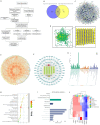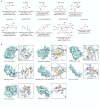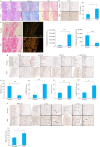[Oral submucosal fibrosis induced by active components in areca nut: a network pharmacology-based analysis and validation of the mechanism]
- PMID: 38862451
- PMCID: PMC11166722
- DOI: 10.12122/j.issn.1673-4254.2024.05.15
[Oral submucosal fibrosis induced by active components in areca nut: a network pharmacology-based analysis and validation of the mechanism]
Abstract
Objective: To explore the pharmacologically active components in areca nut that induce oral submucosal fibrosis (OSF) and the possible mechanism.
Methods: The chemical components in areca nut were analyzed using Thermo QE plus liquid chromatography tandem high-resolution mass spectrometer and Compound discover 3.2 data processing software. The chemical activity of the top 20 compounds was analyzed based on Chinese Pharmacopoeia (2015), PubChem, Chemical book, and SciFinder databases. The potential active components, core targets, biological functions and signaling pathways affecting OSF were analyzed by network pharmacology. The targets of OSF were obtained by integrating Genecards and KEGG databases. The compounds acting on the targets were selected from the Systematic Pharmacology Technology Platform of Traditional Chinese Medicine (TCMSP), and the target-compound, compound-TCM, target-compound-TCM network was constructed. Molecular docking was used to analyze the component-target binding. Immunohistochemistry was used to examine the expressions of key proteins in the PI3K-Akt and MAPK pathways in clinical samples of OSF.
Results: The core intersection target genes between the top 10 active ingredients in areca nut extract and OSF involved mainly the PI3K-Akt and MAPK pathways. In the clinical samples, the expressions of PI3K protein decreased and the expressions p-PI3K, AKT1 and PAkt all increased significantly in OSF tissue, where increased JNK protein expression and enhanced activity of c-Jun and c-Fos transcriptional factors were also detected. The OSF patients had significantly elevated plasma levels of IL-6 and IL-8 compared with healthy individuals.
Conclusion: The main active ingredients including arecoline, arecaine, and guvacine are capable of activating the PI3K-Akt and MAPK pathways to promote the expressions of inflammatory mediators IL-6 and IL-8 and induce collagen hyperplasia, thus leading to the occurrence of oral submucosal fibrosis.
目的: 探究槟榔的成分及其促进口腔黏膜下纤维化的机制。
方法: 采用Thermo QE plus液相色谱串联高分辨质谱仪和Compound discover 3.2数据处理软件进行槟榔中药化学成分分析,将检测到的化合物以质谱响应值排序,分析排名前20化合物的活性。化合物活性来源根据《中国药典(2015版)》汇总,数据查询基于PubChem、Chemical book 以及Scifinder数据库。借助网络药理学方法分析槟榔影响口腔黏膜下纤维化(OSF)的潜在活性成分、核心靶点及主要影响的生物功能、信号通路。通过整合人类基因数据库(Genecards)、基因组百科全书数据库(KEGG)等数据库获取OSF的作用靶点。以OB≥30%为条件,在中药系统药理学技术平台(TCMSP)中筛选出槟榔可作用于靶点的化合物,并构建靶点-化合物、化合物-中药、靶点-化合物-中药网络。运用MOE软件的分子对接技术,分析成分-靶点结合的可能性,再利用Pymol软件进行分子对接可视化。最后通过免疫组化在临床样本中验证槟榔是否影响PI3K-Akt、MAPK两条通路涉及的主要蛋白,初步验证槟榔诱导OSF的潜在作用机制。
结果: 基于网络药理学和槟榔粗提物中筛选出前10的化合物与OSF核心靶点中核心交集基因,确定了槟榔可能通过调控PI3K-Akt与MAPK通路。通过免疫组化在临床样本中验证,细胞膜上的PI3K蛋白表达量在OSF患者组中表达下降(P=0.0002),p-PI3K(P=0.0002)表达量上升,进一步激活下游的AKT1蛋白表达增加(P=0.0006),加剧磷酸化蛋白p-AKT蛋白的表达及堆积(P=0.0013);而在MAPK通路中,OSF患者组对比正常组,通过上调JNK蛋白(P=0.0130),诱导下游AP-1复合蛋白c-jun及c-fos转录因子的活性增加,促使其向细胞核聚集;且OSF患者组较正常组血浆的IL-6(P<0.0001)与IL-8(P=0.0095)含量均上升。
结论: 槟榔碱、槟榔次碱、异去甲槟榔碱等槟榔中的主要活性成分可能通过刺激PI3K-Akt与MAPK信号通路,促进炎症介质IL-6及IL-8的表达,诱导胶原增生,导致口腔黏膜下纤维化病变。
Keywords: areca nut; molecular docking; network pharmacology; oral submucosal fibrosis.
Figures





Similar articles
-
The effect and mechanism of areca nut in ovarian cancer were investigated based on network pharmacology, molecular docking, and in vitro experiments.Biochem Biophys Res Commun. 2025 Jul 22;771:151943. doi: 10.1016/j.bbrc.2025.151943. Epub 2025 May 8. Biochem Biophys Res Commun. 2025. PMID: 40398091
-
Panax notoginseng saponins inhibit areca nut extract-induced oral submucous fibrosis in vitro.J Oral Pathol Med. 2014 Jul;43(6):464-70. doi: 10.1111/jop.12158. Epub 2014 Feb 1. J Oral Pathol Med. 2014. PMID: 24484214
-
[Mechanism of Wuling Capsules against hepatic fibrosis based on network pharmacology and animal experiments].Zhongguo Zhong Yao Za Zhi. 2023 Oct;48(19):5365-5376. doi: 10.19540/j.cnki.cjcmm.20230707.501. Zhongguo Zhong Yao Za Zhi. 2023. PMID: 38114126 Chinese.
-
Areca nut-induced oral fibrosis - Reassessing the biology of oral submucous fibrosis.J Oral Biosci. 2024 Jun;66(2):320-328. doi: 10.1016/j.job.2024.02.005. Epub 2024 Feb 22. J Oral Biosci. 2024. PMID: 38395254 Review.
-
The mechanism of peach kernel and safflower herb-pair for the treatment of liver fibrosis based on network pharmacology and molecular docking technology: A review.Medicine (Baltimore). 2023 Apr 21;102(16):e33593. doi: 10.1097/MD.0000000000033593. Medicine (Baltimore). 2023. PMID: 37083803 Free PMC article. Review.
Cited by
-
Recent Advance on Biological Activity and Toxicity of Arecoline in Edible Areca (Betel) Nut: A Review.Foods. 2024 Nov 27;13(23):3825. doi: 10.3390/foods13233825. Foods. 2024. PMID: 39682896 Free PMC article. Review.
-
Epigallocatechin-3-gallate inhibits the collagen accumulation of oral submucous fibrosis induced by arecoline.Front Pharmacol. 2025 Jan 31;16:1540559. doi: 10.3389/fphar.2025.1540559. eCollection 2025. Front Pharmacol. 2025. PMID: 39959427 Free PMC article.
References
-
- 周明玺, 郭亦晨, 李 珂, 等. 槟榔活性成分及药理毒理作用研究进展[J]. 中成药, 2022, 44(3): 878-83.
-
- 周思安, 刘斯薇, 金力行, 等. 槟榔碱对生殖与泌尿系统的影响[J]. 国际生殖健康/计划生育杂志, 2019, 38(5): 413-7.
-
- 中华口腔医学会, 口腔黏膜下纤维性变诊断与临床管理指南: T/ CHSA 011-2022 [S]. 2022.
Publication types
MeSH terms
Substances
LinkOut - more resources
Full Text Sources
Research Materials
Miscellaneous
